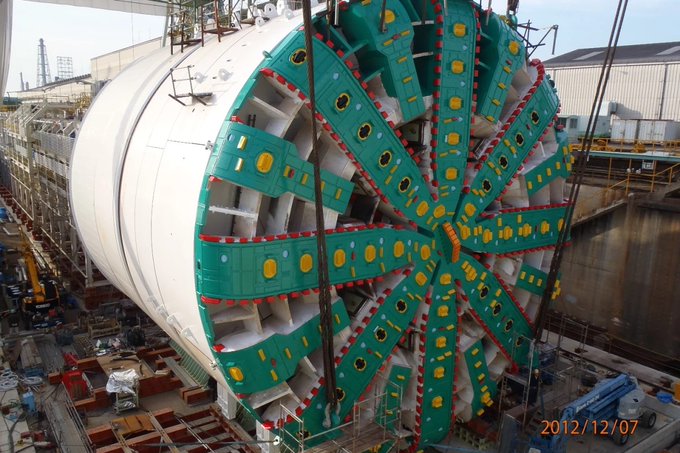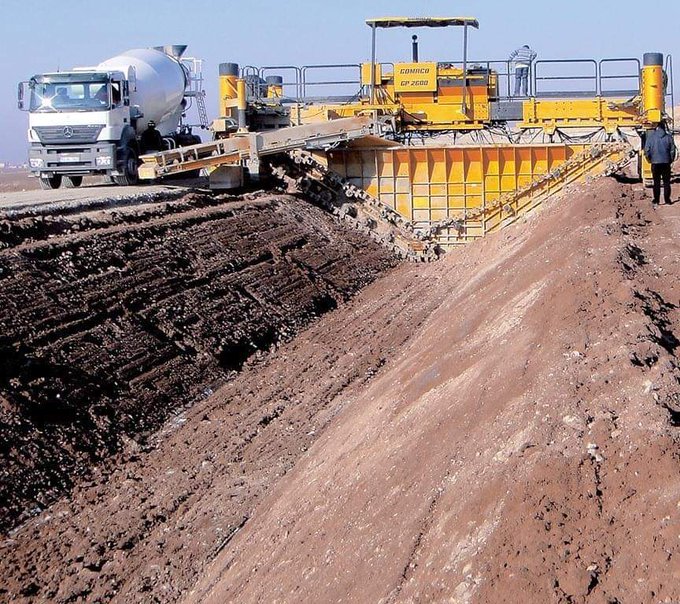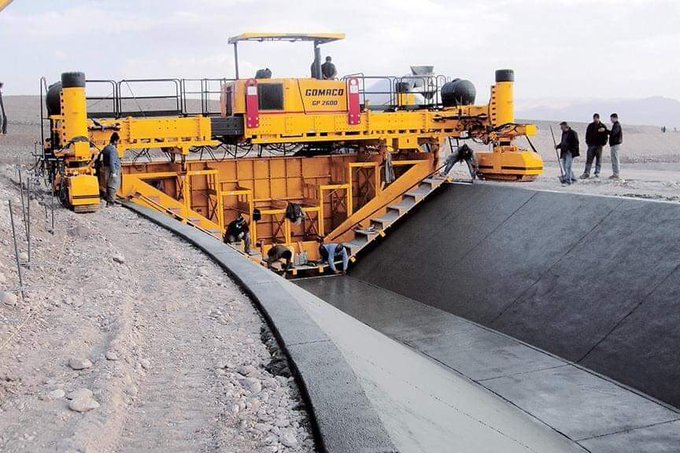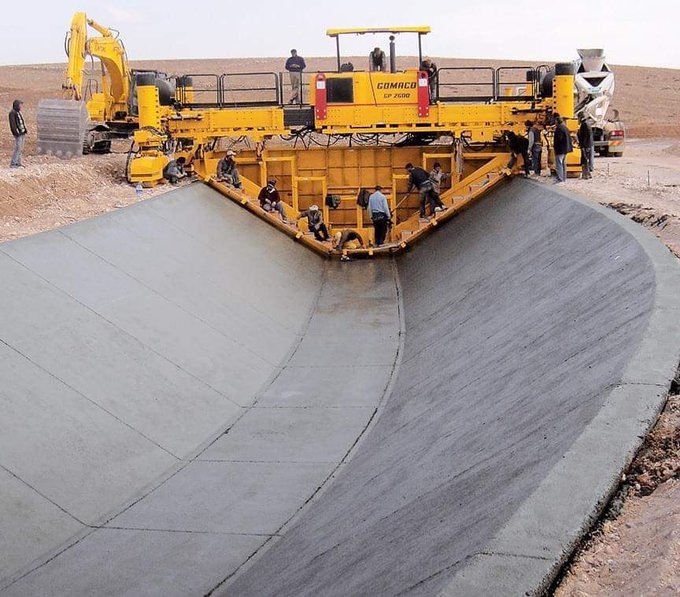There’s something about watching mega machines at work that’s inexplicably satisfying. But watching them carry out precise, yet gargantuan, tasks really scratches an itch you didn’t know you had! From dredging and trenching to carving out perfect tunnels underneath cities, let's explore some extreme machines doing seriously perfect work!
Ponsse Harvesters
The word harvester alone probably gets most of you thinking about combine harvesters, which reap fields of crops like corn and wheat. But the harvesters that Ponsse make reap something a little larger than corn! These logging machines are daringly designed to take down entire trees, and all without the operator ever stepping foot outside of their comfy little cab! How’s that possible?
Their Scorpion model, for example, works on eight, huge 26 ½ inch tires that carry the 25-ton vehicle up the sides of steep and uneven forest terrain. Here, it uses that massive mechanical arm to swing a harvester head around the base of a nearby tree. The heads the scorpion uses weigh a whole ton on their own and contain every tool needed to take a tree down! Once the tree is secured in its grip, a retractable chainsaw slices the trunk from its base. Then it’s turned sideways, and rollers slide the tree through the head where a series of razor-sharp delimbing knives slice off any branches.
PONSSE Scorpion | Product video | Summer 2013 by PonssePlc Considering how awesome this looks, I bet those operators find it real hard not to get carried away! Fortunately, these harvesters come with inbuilt measuring sensors to ensure the lumberjacks don’t try cutting down trees that are too big for their machines to handle!
Although, with the right heads, they can handle a lot. The largest of Ponsee’s harvesters heads, known as an H 10, is more than 7 ½ ft tall and can process logs that are a whopping 3 ft in diameter!
PONSSE H10 by PonssePlc Kojimagumi Gosho Grab Dredger
Ever wondered how construction companies excavate underwater areas? One of the simplest, and most oddly satisfying, ways this is done is with a grab dredger. These machines rely on middle opening, clam-shell buckets that are attached to gigantic crane barges, which are floated out to the areas that need excavating.
These huge buckets are dropped into the water and, thanks to their sheer weight, sink down onto the seabed. Then, using hydraulics, they scoop up soft materials, like sand and mud, and drag it back up to the surface where it’s deposited onto a waiting barge.
As impressive as this operation looks,
Kojimagumi’s Gosho Grab Dredger takes this kind of excavation to brand new heights, or, to be more precise, depths! At almost 330 ft in length and 120 ft wide, this massive machine weighs in at a colossal 7,052 tons. That makes it the largest and heaviest grab dredger in the world!
Its behemoth bucket, which weighs in at a staggering 370 tons on its own, can work more than 150 ft beneath the waves. That’s so heavy that, for perspective, it’d be like dangling a large passenger jet at the bottom of the ocean!
GOSHO The world's largest grab dredger by 株式会社小島組 KOJIMAGUMI CO., LTD. But once it gets there, the bucket can scoop up over 7,000 cubic ft of sludge, that’s enough to fill nearly 900 bathtubs! Well, considering it can haul up a maximum of 690 tons of sludge at a time, I wouldn’t want to be stood underneath this thing when it opens up!
Damen CSD 500 Cutting Suction Dredger
How do smaller, more precise dredging operations work? Well, say hello to the Damen CSD 500 Cutting Suction Dredger. It may look like some sort of torture device, but it’s actually designed to remove muck and mud from sea and riverbeds during mining and general dredging operations.
So how does it work? Its intense-looking, five-bladed cutting head is just over 5 ft in diameter and is covered with 70 separate little chisels. This can stretch out or drill down more than 45 ft below the waterline, where it digs up any debris in its way.
As it churns up the earth and sand, the resulting slurry is sucked up at a rate of more than 141,000 cubic feet per hour. That’s enough to fill an Olympic-sized swimming pool with sludge every 30 minutes!
But this vessel is only 126 ft long and 26 ft wide, so where does this Olympic amount of muck go? Well, discharge pipes attached to the vessel can be laid out along the shore, dumping the excavated sand and sludge at designated depots further inland. Good luck to any Olympic athletes who decides to take a dip in that!
Cutter suction dredger mining sand for nearby road construction project by Damen Colmar Rail Shear
If you had to guess, how heavy would you think a yard of mainline railway track was? Even though they’re deceptively slim, they’re made out of steel, meaning a single yard of modern track can weigh up to a staggering 140 lbs! With that in mind, how are workers meant to dig up and clear such weighty tracks?
Lucky for them, the RP2000 Rail Shear exists! It may look like some sort of metal dinosaur, but the jaws of this beast would put even the strongest T-Rex to shame. It can snap a rail like a twig!
VTN RP2000 Łamacz szyn (Rail cutter, Rail breaker) by Reschke Polska
Attached to a hydraulic arm, the almost 6 ft high cutting head of this amazing machine weighs in at more than 2 ½ tons, and it puts every ounce to good use. It grabs the rail horizontally in its V-shaped grip, and through its heavy-duty hydraulics, it applies a mammoth 1000 tons of pressure to it, snapping it in twain. Now that’s what you call a power tool!
Tunnel Boring Bertha
Have you ever wondered how huge tunnels for subways and highways are carved out underneath big cities? Well, massive infrastructure projects like this are too big for one man and a shovel to tackle alone, which is where Tunnel Boring Machines, like Bertha, come in to help.
Bertha was a 325 ft long, nearly 7,000-ton behemoth boring machine that was used to dig a 1.7-mile tunnel under the city of Seattle. The $80 million machine was shipped over from Japan back in 2013, and the massive 57 ½ ft cutting wheel was fired up later that same year. As it ground its way through the earth, the blades carried the debris through a screw turn which travelled back through the machine and out of its way. Using hydraulic jacks, Bertha lay a series obf concrete segments behind her, matching the tunnel curvature. Once each new concrete ring was in place, the jacks could push against them and propel Bertha forward, leaving a completely sealed, near-60 ft diameter tunnel behind it. But it was essential that this work didn’t send any dangerous tremors through the city above, so it could only slowly chew through 35 ft of earth a day! However, just over 1000 ft into the project, damage to Bertha’s cutterhead meant it suddenly overheated and couldn’t move! After a costly two-year delay, a recovery pit was dug down in order to replace the cutterhead. Once in place Bertha was finally put back to work, and two laborious years later in 2017 she finally broke through to the other side!
The ULTIMATE look at Bertha’s breakthrough by wsdot Bucket Wheel Excavators
A lot of these extreme machines are pretty huge, but none of them come close to the sheer size, or spectacle, of Bucket Wheel Excavators.
These astonishing machines are used to excavate the huge amounts of soil lining coal seams in open pit mining operations. The buckets efficiently shovel up the dirt and, as the wheel rotates, drop it onto a conveyor belt. The belt runs along the length of the excavator’s boom and dumps out the soil at the other end. They’re absolutely astounding to watch in action, but it’s not until you get a look at the Bagger 293 that you see how impressive they really are. At 738 ft long, 151 ft wide, and a mammoth 314 ft high, this beast is one of the largest land vehicles in the entire world!
The World’s Largest Bucket Excavator | Colossal Machines | National Geographic UK by National Geographic UK
From above, it may not seem all that big, but the wheel on its front is a gargantuan 70 ft in diameter alone, which is the same size as an average 6 story building! As it rotates, the 18 buckets on its wheel scoop up almost 20 cubic yards of earth each. That means in about 163 scoops, or just 9 rotations, this thing can shovel up enough earth to fill an entire Olympic swimming pool! While you’ll never see one of these steely titans filling up a pool, like some sort of glorified pool boy, they certainly know how to make a splash.
Bucket Wheel Trenchers
That brilliant bucket wheel design isn’t just used to move mind-boggling amounts of earth from mines. On a much smaller scale, that efficient excavation wheel can be used in machines like the Allcons EW200 Trencher.
Just like its Bagger brother, the buckets on this machine scoop earth up as it’s driven forward. It then dumps the earth onto a much smaller conveyor belt where it’s shot off to the side, leaving a perfectly cleared trench in its wake. It can continuously excavate up to 11,300 cubic feet of earth an hour, which is enough to fill about 1,400 bathtubs! With a trapezoidal mold trailing behind it, the resulting trench can be sculpted into a V shape, ready to be lined with concrete to make a well-sealed gutter or canal. But if you need a regular trench digging without that fancy V shape, then
Tesmec’s 1475 XL EVO Bucket Wheel Excavator’s got you covered! Like the EW200, it scoops up the earth using that huge 13 ft diameter wheel while moving at a top speed of just 1.5 miles per hour.
Tesmec 1475 Bucket Wheel Trencher - UK - Pipeline by Tesmec S.p.A. Even though its wheel is about a 5th the size of the Bagger 293, it’s still about 1 story tall, and can dig 9 ft down into the earth! So, the trenches it digs are perfect for laying thick cables and pipelines without having to upheave huge swathes of earth. Operating this thing must be buckets of fun!
Tesmec Chainsaw Trencher
If you need a trench digging through harder, rockier ground, the most efficient type of machine available is also, luckily, one of the most badass looking! Meet the Tesmec 1475 Chain Trencher, a 100-ton excavator that has the added bonus of looking like a supersized chainsaw!
1475 TESMEC TRENCHER by Dilaver Altuntaş Unlike its bucket wheeled brothers, the spiked conveyor of this excavator is set on a hydraulic hinge, meaning it can pivot down much deeper into the rocks below. As the spiked train of its conveyor tracks chew through the rocks, the hinge allows it to dig down to a maximum depth of 16 ft! Once it’s churned the rocks up, the loose debris is carried onto a separate conveyor system, which is then shot out of the side of the machine. Even though it works through much tougher sediments than the bucket wheel excavators, it can still drag up more than 7,000 cubic ft of stone per hour. That’s enough to fill the average trailer of not on, but two 18 wheelers! Not only that, but I bet it would double up as one heck of a weapon. That’d definitely give King Kong an edge against Godzilla!
Kemroc Cutter Wheel
While bucket wheel and chainsaw trencher designs are great for excavating wide gutters, the need for narrow trenches requires a more precise approach. And that’s where the Kemroc SMW Cutter Wheels come in!
Attached to a hydraulic excavator, the largest of these spiked wheels reaches over 8 ft in diameter and can cut down more than 3 ft into hard surfaces like asphalt. When the required depth has been reached, the wheel is then pulled along by moving the excavator arm or by driving the excavator slowly backwards.
KEMROC SMW cutter wheels for narrow trenching in soft and medium hard rock by KEMROC With a blade that’s just under 6 inches wide, the narrow slot trench it leaves makes it perfect for laying cables without needing to dig up an entire road! And thanks to that large metal cover, loose rocks being dug up don’t fly out in every direction. Instead, debris is fed up to that chute at the back, where it’s deposited neatly on the side of the road.That wheel can dig through asphalt like a hot knife through butter! But Kemroc also makes cutting wheels that can slice through much more than asphalt! Its
DMW series, like the SMW, boasts wheels with a maximum diameter of around 8 ft. But with a maximum width of 1.3 ft, these wheels can exert more than a tremendous 10,000 lbs of force! This allows them to effortlessly, and satisfyingly, cut through materials like solid rock, and even reinforced concrete!
Bridge Demolition Using KEMROC DMW Cutter Wheel by KEMROC
Tree Crushers
In Dr Suess’ famous story of The Lorax, an entire forest is cleared by funny fictional machines which look too hilarious to be real.
The Lorax (original) by jefronty But astonishingly, forest crushing machines do exist, though they’re definitely not fit for a kids story! Like the lovechild of a steamroller and a chainsaw, these badass behemoths were designed back in the 1950’s to barrel through forests and take out everything in their path.
YouTube Video by Unknown They may all look huge, but the undisputed daddy of them all was the LeTourneau G175 tree crusher! At 56 ft long, and 35 ft wide, the steely behemoth weighed in at a colossal 175 tons, making it the largest tree crusher ever built!
Tree crusher in Mackenzie,BC by Off the rails Productions In place of wheels, it rolled around on two huge, spiked rollers that crushed any and all foliage before it. It was transported to Canada back in 1964 to help clear a section of land for the Kennedy Siding airstrip. However, it was so big that it took 6 rail cars to transport it, and then required a phenomenal 4 days just to offload it! As more manageable machines were developed, the G175 became obsolete, and crushed its very last tree back in 1965. Today, it can be found in British Colombia as a tourist attraction, and even though it’s no longer in action, its spiked rollers still leave one heck of an impression!
ArmorFlex
Sometimes, machines are only partially responsible for the perfect work they do, as proven by materials like ArmorFlex.
These are interlocking concrete blocks that are connected ingeniously by a set of steel cables, linking them together like large stony mats. So, instead of having workers haul each heavy 32 lb block from the truck to the ground, this simple solution allows cranes to effortlessly lift the mats into place!
It was this strangely satisfying technique that was used to line the low water crossings of the California Valley Solar Ranch back in 2011. The crossings needed to support construction traffic, so a series of loose blocks simply wouldn’t do. Instead, the construction company purchased a series of 8 x 21 ft ArmorFlex mats, which each weighed more than a ton! Even so, with a few excavators fitted with specially modified arms, five of these mats were laid down and locked together in less than 3 hours! Does this look like the world’s most extreme Lego set to anyone else?
ArmorFlex Hesperia installation by MaryJaneMACLEOD Helicopter Aerial Saw
Can you think of anything more terrifying than seeing a giant circular saw heading right towards you? How about if 10 of them were attached to a helicopter while slicing through a forest just a few feet away from you?
YouTube Video by Unknown
Despite what it looks like, this isn’t a rogue helicopter pilot with a grudge against greenery. That menacing device is actually a Helicopter Aerial Saw, a tool that’s flown along remote locations to trim back overgrown trees in the way of things like train tracks and powerlines. This design utilizes a 20 ft shaft that carries upwards of 10 separate circular saws.
Altogether, this sharp setup weighs a whopping 830 lbs, and is carried about 90 ft below the helicopter hoisting it into the air. For perspective, that’s like swinging an average sized elephant off an 8-story building, except this elephant is also covered in super sharp blades that could easily cut you in half! As dangerous as it sounds, the aerial saw isn’t just left to dangle around in the wind! It’s attached to a mechanical boom pole that’s connected to the helicopter, which can be remotely controlled by the pilot inside! With the push of a button, the blades, which are powered by a 28-horsepower engine, spin at a staggeringly fast 4000 rotations per minute. That’s more than 66 times per second!
Vermeer Compost Turner
For anyone who doesn’t have a green thumb, compost is a natural substance made by decomposing organic materials, like food waste and plant matter, into a nutrient rich fertilizer. It’s important to turn the compost to ensure fresh air and essential microbes reach every inch of it.
But at huge industrial facilities, how is anyone meant to turn that much compost? That’s where the hilariously specific
Vermeer CT718 Compost Turner comes in.
CT718 Compost Turner Drive Options | Vermeer Recycling Equipment by Vermeer At 18 ft wide, this rolling rectangle has a 7 ft tall arch in the middle, known as a windrow, that passes over the long lines of aerating compost. As it does, a specialized drum at its center, covered in stocky steel flails, rotates around, mixing up the compost at the very center of the pile. Despite being churned up, the shape of the windrow keeps the compost in its neat little rows as the turner passes over, all while efficiently aerating it! Thanks to all its fancy features, this mega machine can process a whopping 108,000 cubic ft of compost an hour. For perspective, that’s enough to fill 257 standard shipping containers with compost every 60 minutes!
Rotary Snow Ploughs
At a glance, the massive blades attached to the front of the train below make it look like an insane war wagon that could cut up anything in its path!
These types of trains aren’t designed to cut up people. These railed units are rotary snow ploughs, which are deployed to clear train tracks when the snow gets impossibly deep. Using those large circular blades at their front, they cut through massive snowbanks blocking up tracks in chilly climates! As they grind their way forward, the centrifugal force of the blades chews the snow up and spits it out of the side, like a giant woodchipper on rails!
Ex Southern Pacific Rotary Snow Plow Charges Up Donner Summit by Benjamin Pechner
One of the largest bladed beasts to have ever been built is the 1966 Union Pacific Rotary Snowplough. At a gargantuan 183 tons, this thing weighs the same as 62 African elephants, and is the heaviest snowplough of its kind. A 3000-horspower engine drives those enormous 12 ft blades, which can spin round at a whopping 150 rotations per minute, making easy work of even the tallest snowbanks!
But it’s not a self-propelled vehicle, and being that heavy means that it can take up to 4 locomotives to push it through the snow. And even then, it can only reach a top speed of 6 mph! In those treacherous conditions, "snow" and steady wins the race.
Wave Power Generator
When you read about renewable energy, most of you probably start thinking about solar panels and wind turbines. But in Latin America, there’s an innovative machine promising to bring a wave of change to the way we harness the power of the sea! Meet the Coppe Subsea Wave Power prototype generator, which was installed back in 2012 off the Brazilian Port of Pecém.
Usina de Olas del Pecém by Coppe UFRJ Those two yellow mechanical arms stretch 72 ft out into the sea, each of which is connected to a large buoy that’s roughly 32 ft in diameter. They look a little out of place on the shoreline; a bit like two ocean sized soup spoons rather than ground-breaking renewable energy tech. But there’s much more going on beneath the surface! As the waves hit the buoys, the arms move up and down, working a series of hydraulics that circulate fresh water confined in a high-pressure pump. The resulting water jet sprays onto an attached turbine, which in turn powers a generator!
Through this process, the two waving arms on their own can generate up to 100 kilowatts of electricity. Currently, that’s not even half of what it would take to power one standard home for a month, but it’s a promising start. After all, Brazil has 4,600 miles of usable coastline that could host a project like this!
Slipformers
In the world of construction, very few processes can be as satisfying to watch as slipforming. This is a little-known technique where concrete is poured out onto a continuously moving surface and shaped by a machine, like the ingeniously designed Gomaco GP-2400!
GOMACO GP-2400 Concrete Slipform Paver by GOMACO Corporation It works by placing a measured supply of concrete in front of the paver, which is then spread, shaped, and consolidated at a specific height. Raised up on a telescopic frame, the GP-2400 can stretch up to a staggering 24 ft across while being carried by up to 4 caterpillar tracks. These allow it to inch forward at a maximum operating speed of just 44 ft per minute, leaving a singular slab of concrete in its wake!But Gomaco don’t just build in straight lines, or in this case, slabs. This GP-2600 slipform paver was fitted with a custom build trapezoidal mold in order to line the dipped dimensions of Turkey’s Batman Canal.
Pre-mixed concrete was transported to the paving site and discharged onto a conveyor, which dumped the concrete into the paver’s hoppers. As it moved forward, a chain trimmer on the other side of the mold refined the shape of the canal.Then the wet cement was fed through and flatted into the trench, covering it evenly along the sides and bottom! Even with so many complex processes in action, this slipform machine managed to lay almost 2000 ft of concrete a day!Although, the GP-2600 isn’t the only canal slipformer on the market! Allcons Series PC6000 concrete hinge liner is so huge it can straddle canals that are over 80 ft wide!

While it works similarly to the GP-2600, the concrete conveyor belt distribution system on its top allows this machine to lay more than 2600 cubic ft of concrete per hour! Assuming the concrete was about a quarter foot thick, that’d be enough to cover an entire football pitch in just 5 ½ hours! That would certainly make for one dirty game of football. If you were amazed at these satisfying extreme machines, you might want to read about
extreme engineering machines. Thanks for reading!

























